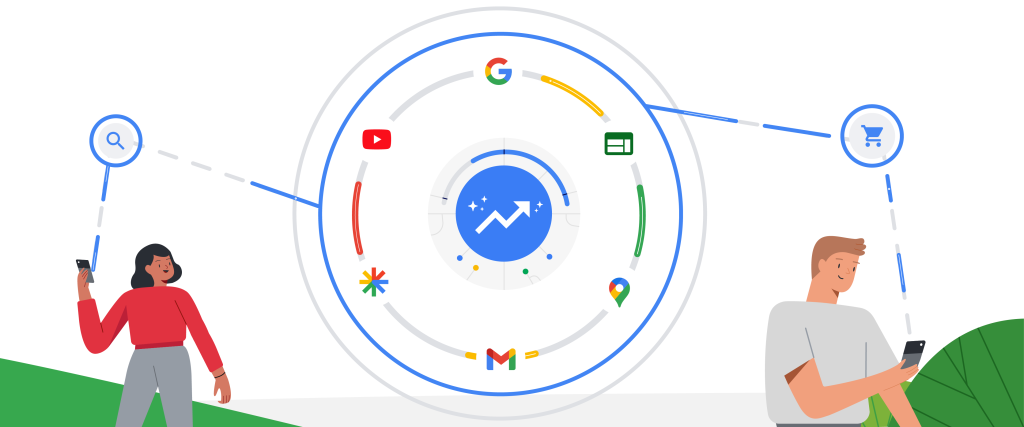Google Ads now offers Performance Max campaigns that allow advertisers to create one campaign and display their ads anywhere users interact with Google’s services, such as in Maps, Discover, Search, and Gmail. Despite fragmented user behaviour, this technology promises to simplify advertising. This is a particularly appealing promise for new advertisers who might be unfamiliar with Google Ads. There is a risk that introducing yet another campaign type will confuse existing advertisers. This article gives some insight into Performance Max.
Smart Shopping, Gmail, and Local campaigns will be replaced by Performance Max for now. In the meantime, there will be other campaign types available. According to Google, the transition to Performance Max will take place by the end of September 2022. In April 2022, Google began offering a 1-click upgrade tool to make it easier to upgrade Smart Shopping and Local campaigns to Performance Max.
Previously, Gmail campaigns could not be edited, but now Google has announced that stand-alone ones will be deprecated on June 28, 2022. A Discovery campaign or Performance Max campaign can be used to access this inventory. The Google data indicates that Performance Max campaigns are 13% more effective than current campaign types at the same price or lower. It is best to think of Performance Max as an incremental play, which should be enabled alongside your current campaigns. You do not need to turn off Smart Shopping or Local unless you have those campaigns. Performance Max should be combined with your existing campaigns.
Using Google Ads Performance Max: Tips For Success
-
Video Asset
Creating a Performance Max campaign can be challenging, not because of the bidding strategy or audience signal, but because of the number of assets needed. You will be required to feed the campaign many texts, images, and video assets since it covers many different types of inventory. You’re probably aware that adding video assets to a Display campaign is optional. As far as Performance Max is concerned, it is mandatory. Alternatively, Google Ads will generate video assets if you do not provide any. The auto-generated video assets currently leave something to be desired, even though I’m sure they will get better over time.
You can use Canva’s free video ad templates to create a short animation for your image assets if you don’t have any video assets. Before you can use your video in a Google Ads campaign, you must upload it to YouTube. The “Unlisted” visibility option will prevent your video ad from appearing on your channel.
-
Audience Signal
Google Ads introduced the concept of audience signals with the launch of Performance Max campaigns. When you add audiences to your campaign, Google Ads asks you to specify exactly which type of users you want ads shown to. It’s up to you to decide what you want to target.
Google Ads uses audience signals to determine which users you want to show ads to. The audience segments will, however, only be used as a starting point by Performance Max when serving ads. Following that, it will display ads to people whose actions suggest that they are likely to convert once it has gathered data. It’s similar to how ad targeting works for Video and Display campaigns: you select the segments, but Google will then show ads based on the likelihood of conversion. “Optimised targeting” being rebranded as “audience signal” proposes more control to the user rather than letting machine algorithms make decisions for them.
Audience segmentation should include Remarketing and Custom audiences to set the audience signal off in the right direction. Ideally, pixel-based website remarketing would be best, but a customer list is also working. I use the most converting search terms from Search & Shopping to build custom audiences. Unlike data segments, Audience Manager separates audience signals from data segments in a Google Ads account. At the account level, they’ll be accessible even if they’re created within a Performance Max campaign.
-
Customer Acquisition Rules
Despite replacing Smart Shopping with Performance Max, customer acquisition rules remain. Only new customers can be bid on in your PMax campaign settings.
Using Performance Max to focus on acquisition instead of branded search and remarketing is an excellent way to use the format if your campaign is heavy on remarketing and branded search. It is important, however, that you revalue your expectations; PMax campaigns geared toward acquiring customers are less effective than those geared towards bottom-of-funnel conversions; you will need more time (and possibly more ads) to convert new users into customers with a PMax campaign geared towards acquisition.
Closing Thoughts
Now that we have been testing Performance Max for some time, we’re learning more about the newest campaign type on Google Ads.
Auto-generated video assets and URL expansion are some aspects of Performance Max that are entirely new. Bidding based on conversions is another aspect that seems distantly familiar. Start testing Performance Max now if you are an eCommerce business. Lead generation businesses can do the same, but they must ensure that their conversion tracking setup is as good as possible. You should prepare enough budget so Google can learn and optimise based on the data you generate.
With Google advertising, Warren Digital can help you rank on top of search results while combining analytics and data to ensure that you succeed. Make yourself the go-to solution for your customers’ problems – get in touch with our friendly experts and choose us as your Google Ads agency today!





